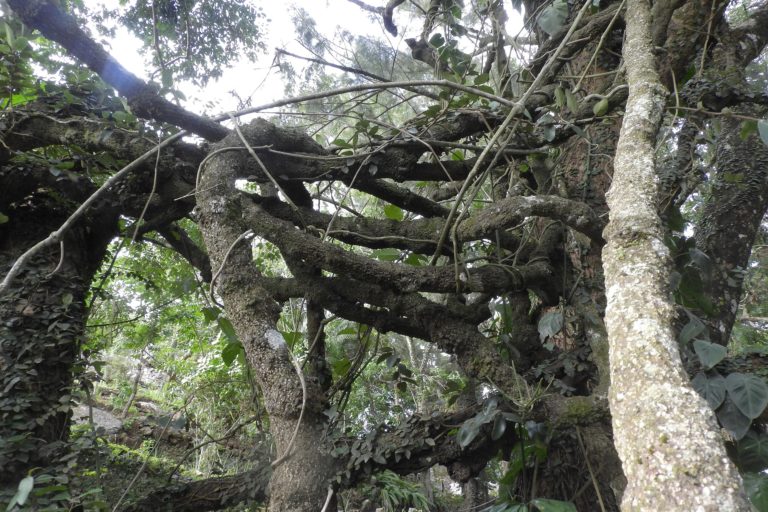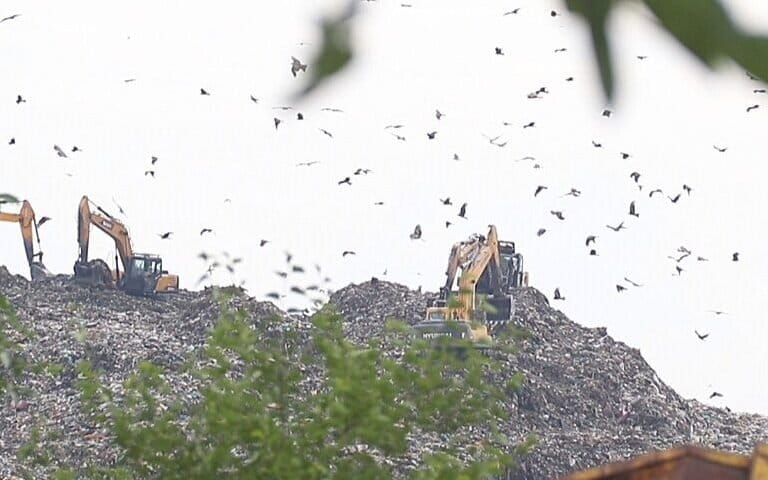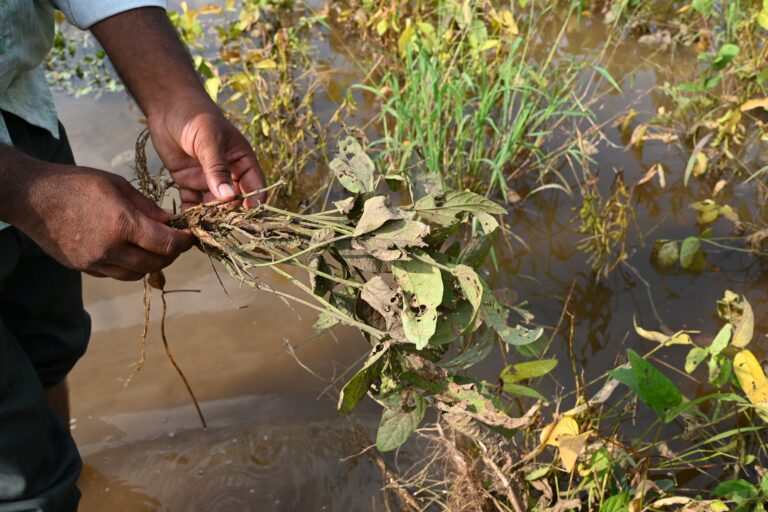- Lianas are a group of woody climbers that use trees to ascend to the canopy. They are polyphyletic, which means they have evolved from different ancestors.
- Their diversity and abundance have often been considered as criteria to differentiate temperate and tropical forests.
- Ecologists are concerned that the effect of lianas on carbon storage in forests will change over time as climate changes and natural and anthropogenic disturbances change the diversity of flora species within the forests.
Who can forget the image of Tarzan swinging from tree to tree, crossing streams hanging on woody vines? Tarzan’s natural bridges and ladders in the forest are a category of plants known as lianas. For long, lianas have been ignored, cut down and cleared as part of forest management. But they are beginning to be noticed, as some groups of scientists studying them have demonstrated their value in forest conservation.
What are lianas?
Lianas are a group of woody climbers that use trees to ascend to the canopy. Their vascular structure (xylem and phloem, that plants use to move water and minerals) is different from the strong and sturdy one present in trees; it has evolved for processes such as stem and root elongation, tissue development for water and nutrient transport, canopy development and reproduction, consequently making them dependent on trees for structural support.

Reaching the canopy is essential for lianas due to their need for sunlight, and they have developed several strategies to achieve that. Some have evolved as twiners whose stems curl around tree branches. Others have tendrils arising from their own leaves, stems or branches that attach to the supporting tree. Many lianas also have thorns, spines, or adventitious roots, as well as downward pointed adhesive hairs binding them to the host tree.
As they depend on trees for survival, lianas are described as structural parasites, like epiphytes and hemi-epiphytes (aerial plants which derive their nutrition and other needs from the air and their host plant). But unlike aerial plants that never need to touch the soil, lianas are rooted to the ground.

Liana abundance and diversity
Lianas are markers of tropical forests, being more abundant in tropical forests than temperate ones and constitute about 25% of species richness in these forests. Their diversity and abundance increase with decreasing latitude, and they appear to flourish better in warm, lowland tropical forests. In such areas, they grow much faster than trees, shrubs or herbs.
Research about lianas in India is limited, but a few studies have reported their presence, diversity and richness in Indian forests.
One study by researchers at The Salim Ali School of Ecology and Environment at Pondicherry University showed that their species richness and density varied considerably among forests of Western Ghats, Eastern Ghats and Coromandel coast.
Another study done in four tropical dry evergreen forests of peninsular India revealed the presence of 2,678 lianas belonging to 35 species in 32 genera and 22 families. Moreover, 28% of trees in the wet evergreen forests of Anamalais hosted lianas, whereas, at Agumbe, only 16% of trees had lianas. Liana species diversity is also closely linked to the different successional stages of a forest, with tendril climbers seen in young forests and twiners being more common in older forests. They play an essential role in a forest’s ecosystem processes by virtue of their unique physiology. Their high sap flow, facilitated by their root systems, which go deeper than tree roots in the soil, long and wide vessels and their spread in the forest canopy, means they can transport more water even during the dry seasons. They also have higher photosynthetic biomass than most woody plants, meaning they play a significant role in the forest’s carbon budget. However, this is not yet clearly understood.
A 2015 study in Panama’s forests found that lianas were responsible for increased tree mortality and reduced tree growth, greatly reducing net carbon uptake and storage. In addition, lianas altered the carbon storage above ground, shifting its location from stems to leaves. The researchers also found that in presence of lianas the trees attained only around 24% of the carbon-sink potential as opposed to liana-free forests where the carbon storage was 30% or more.
Read more: India has high proportion of priority areas for tree conservation and restoration, says study
Role as pathways, bridges and havens
Lianas’s structural twisty-ness is also a boon for other forest denizens. They serve as pathways, bridges and swings for many animals such as monkeys, squirrels, sloths, bats and several species of insects and other arthropods in search of food, shelter or prey.
A 2015 study showed that 16 primate species in 10 countries used 150 liana species from 47 families. Their primary food source was fruits & leaves, but flowers, nectar, piths, rhizomes, stalks, bark and buds were fallback foods for crunch times. Primates consider lianas in selecting trees to sleep, home range, foraging, reproduction, locomotion and group partitioning.
Lianas sustain arthropod diversity. Their copious foliage is more nutritious and does not contain biochemical defences like in trees. The high turnover of leaves provides phytophagous insects with tender, fresh ones to eat and more significant amounts of nitrogen and phosphorous. In some ways, lianas serve to protect trees from insect herbivory. Scientists have found that insect foraging on trees was greatest in those forests where lianas had been removed.

Lianas flower profusely, and their flowering produces high quantities of pollen and nectar. Their floral nectar is a crucial nutrient for ants. In addition, large bees and beetles pollinate them. Over 700 arboreal beetle species were found to be associated with lianas and trees in the forest of Panama. For invertebrates that do not fly, the forests could well become their death trap without lianas to help escape predators such as the aggressive Aztec ants that reside in these forests.
But ecologists are concerned that these relationships will change over time. Forests will change over time as climate changes, and natural and anthropogenic disturbances change the diversity of flora species within the forests and around them. The fact that foresters also remove lianas from forests is a cause for concern.
Lianas and human interactions
Liana dynamics affect the growth of forests. In heavily logged forests, they interfere with forest regeneration. When a treefall event creates gaps in forests, adult lianas survive and proliferate in these gaps interfering with tree growth. Whereas tree species colonise such gaps by resprouting, lianas do so by producing many independently rooting stems. Thus, they can grow and colonise disturbed areas more quickly than vascular plants. Even in low abundance, they negatively affect trees surviving in closed-canopy forests or managed ones. They reduce tree growth rates, damage trees during timber harvest and distort tree trunks, thereby lowering their value for timber. Lianas compete with trees above ground for light and CO2 and below ground for soil nitrogen and water. It is believed that competition for soil water could be intense in forests that experience low rainfall.
Because of the detrimental effects they can have on their tree hosts, the liana-tree interaction has been of great interest to foresters and ecologists alike.

Humans use lianas in different ways. My first introduction to these plants as a source of drinking water was in the forests of Western Ghats. One of the watchers from the tribal community cut a small branch of a liana species and water came gushing out. It was quite a dramatic sight for the students who were with me. He informed us that the quantity of water varied from species to species, but if they ran out of drinking water, the liana was their source to quench their thirst. Kani forest watchers inside Kalakad Mundanthurai Tiger Reserve (KMTR), source water from a gymnosperm, Gnetum ula when their own source is finished.
Eighty three species of liana are used for medicine and about 197 pharmaceutical concoctions are made using these species to address many diseases. About 16 species are believed to have aphrodisiac properties. Some species are used in mouth and teeth hygiene. Twenty species serve as food for humans while 19 species are used in the construction of houses. Some of the lianas are used for artisan work while a few are used for hunting.
For a long time, they have been seen only as plants to be removed for forests to thrive. But studies by researchers are beginning to reveal that lianas have an essential role in the forest dynamics than they have been credited with. In a world facing forest and biodiversity loss at an alarming rate, the role of liana in forest dynamics and maintaining species diversity needs to be urgently reviewed.
Read more: Tracing an ancient voyage of tropical African trees that travelled to Southeast Asia via India
CITATION:
Schnitzer, S. A., & Bongers, F. (2002). The ecology of lianas and their role in forests. Trends in Ecology & Evolution, 17(5), 223-230.
Van Der Heijden, G. M., Powers, J. S., & Schnitzer, S. A. (2015). Lianas reduce carbon accumulation and storage in tropical forests. Proceedings of the National Academy of Sciences, 112(43), 13267-13271.
Arroyo‐Rodríguez, V., Asensio, N., Dunn, J. C., Cristóbal‐Azkarate, J., & Gonzalez‐Zamora, A. (2015). Use of lianas by primates: more than a food source. Ecology of lianas, 407-426.
Yanoviak, S. P. (2015). Effects of lianas on canopy arthropod community structure. Ecology of lianas, 343-361.
Banner image: A liana plant with lenticels, a porous tissue that allows the plants to breathe and exchange gases. Photo by Dinesh Valke/Wikimedia Commons.













